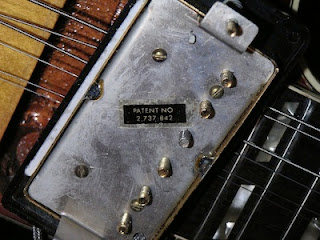There are a lot of great singers in rock and pop, but for sure one of the best through the years has been Paul McCartney. Take a listen to this stunning vocal on his classic "Maybe I'm Amazed" from his first solo album. It's a rare combination of tone and passion that you so rarely hear these days.
Here are some things to listen for:
1. There's a very subtle effect on Paul's voice. I'm told that he favors a 175 millisecond delay on his vocals both in the studio and live, and you can hear it here, with a little bit of a short reverb tail on the delay as well.
2. The background vocals are Paul and Linda McCartney in a fairly open harmony, and have a more of the short reverb to push it back in the mix.
3. Check out Paul scatting during the guitar solo, which are mixed very low on the final mix.
4. It sounds like Paul did the vocal live while cutting the piano, then overdubbed the vocal on the last verse at 2:04 as the piano leakage changes.
All in all, this is one amazing vocal recorded when Paul was at the very top of his game.
Help Support This Blog
Friday, November 20, 2015
Paul McCartney "Maybe I'm Amazed" Isolated Vocals
Thursday, November 19, 2015
The Mystery Of The Greek Amphitheater Solved
For centuries acousticians have argued over the secret to the excellent acoustics at the amphitheater of Epidaurus in Greece.
Crowds of up to 14,000 people have been able to hear the actors and musicians perform in the theater completely un-amplified, even in the back row, but yet science has been able to say exactly why that was possible.
The amphitheater, which dates back to the 4th century BC, is a masterpiece of architecture by Polykleitos the Younger, but its acoustics have never been duplicated (even by Polykleitos) regardless of the increasing sophistication of measurement equipment at the disposal of the modern acoustician.
Researchers at the University of Georgia have finally unlocked the secret though - it's all in the seats!
In findings presented in an issue of The Journal of The Acoustics Society of America, the scientists involved in the research found that the limestone used in the seats provide filtering and absorption, thereby decreasing crowd noise and low frequencies that might interfere with the performance. All the frequencies below 500Hz are attenuated.
That's not all. It seems that the slope of the seats reflect the high-frequencies back towards the audience, making it easier for them to distinguish the sounds of the performers.
Then there's the fact that corrugations of the seats act as bass traps, which then lead to the listener filling in the frequencies psycho-acoustically, just like what happens when listening to an MP3.
So lets see - absorption, bass traps, reflection angles - sounds like modern recording studio building techniques to me. It just goes to show that no matter how things evolve, they still manage to stay the same.
Crowds of up to 14,000 people have been able to hear the actors and musicians perform in the theater completely un-amplified, even in the back row, but yet science has been able to say exactly why that was possible.
The amphitheater, which dates back to the 4th century BC, is a masterpiece of architecture by Polykleitos the Younger, but its acoustics have never been duplicated (even by Polykleitos) regardless of the increasing sophistication of measurement equipment at the disposal of the modern acoustician.
Researchers at the University of Georgia have finally unlocked the secret though - it's all in the seats!
In findings presented in an issue of The Journal of The Acoustics Society of America, the scientists involved in the research found that the limestone used in the seats provide filtering and absorption, thereby decreasing crowd noise and low frequencies that might interfere with the performance. All the frequencies below 500Hz are attenuated.
That's not all. It seems that the slope of the seats reflect the high-frequencies back towards the audience, making it easier for them to distinguish the sounds of the performers.
Then there's the fact that corrugations of the seats act as bass traps, which then lead to the listener filling in the frequencies psycho-acoustically, just like what happens when listening to an MP3.
So lets see - absorption, bass traps, reflection angles - sounds like modern recording studio building techniques to me. It just goes to show that no matter how things evolve, they still manage to stay the same.
Wednesday, November 18, 2015
Here's Why The Sound Of Gibson Pickups Changed Through The Years
 |
| A Gibson PAF Humbucker |
As you'll see, there are a lot of external factors that went into making a pickup back then, and those factors pretty much be applied to all instruments in one way or another.
"As if the known factors in building a pickup weren’t enough, consider the many intangible factors as well. For instance, most pickups loose their magnetic strength over time because of environment and electrical interference. Pickups can become weakened or demagnetized completely by leaning your guitar against an amplifier with large transformers, or even from taking your guitar too close to the train motor of a subway (as happened with Andy Summers of The Police).
Another intangible is the fact that tolerances of just about every component were much looser until the 90’s. While the difference was indeed subtle, add enough components at the edge of their tolerances together and you suddenly get a pickup that sounds different even though it’s made the same.
Manufacturing intangibles are a whole other story and for that we’re going to go a bit into the history of the Gibson humbucker.
The Changes In The Humbucker
The first humbucking pickups on the 1957 models of Gibson guitars had a sticker on them saying “Patent Applied For” as the design was in the review cue before being granted a patent (see the figure on the upper left). These became known as PAF pickups (“Patent Applied For”) and have become highly sought after today for their great sound. The problem is that most PAFs sound different from one another due to manufacturing process of the time.
Until 1961 when Gibson standardized the selection process, they randomly used different strength magnets (grade 2 through 5) in their pickups, which accounts for some of the reasons for the different sounds. To make matters worse, sometimes a shorter magnet was selected (mostly seen in gold-plated guitars for some reason), which decreased the power of the magnet as well.
In July of 1961, Gibson consistently began to use all short Alnico 5 magnets, although occasionally a few Alnico 2’s showed up. In 1965, Alnico 5’s became standard in all pickups, which finally brought about a bit of consistency to the process and the sound.
In July of 1961, Gibson consistently began to use all short Alnico 5 magnets, although occasionally a few Alnico 2’s showed up. In 1965, Alnico 5’s became standard in all pickups, which finally brought about a bit of consistency to the process and the sound.
If that weren’t enough, the number of windings on the pickup varied enormously as well, especially in PAFs. The early coil winding machines didn’t have an auto shut-off so the workers would shut off the machine when the bobbin looked full, which was at about 5000 turns. As a result, no two pickups were ever the same.
Even when Gibson bought a winder with an auto-stop, there continued to be problems even though the pickups became more consistent. The stop mechanism was controlled by a fiber wheel which would wear out and break, at which point the workers would approximate the number of winds by timing the wind, which resulted in more inaccuracies.
Since the humbucker is made up of two coils, sometimes the windings of each coil were different even though the total number of turns were correct. This would cause certain mid-range frequencies to stand out and give it more bite.
 |
| Figure 3.28: A Gibson Patent Number Pickup |
By mid-1962, the patent for the humbucker was granted and Gibson changed the sticker to read “PATENT NO 2,737,842” which was actually the patent number for Les Paul’s trapeze tailpiece. No one knows for sure if printing the wrong number was merely a mistake or a way to throw off the competition.
From 1963 to 1975, these “Patent number” pickups are very consistent, as are the ones thereafter when new, more precise winding machines were used (see Figure 3.28).
From 1963 to 1975, these “Patent number” pickups are very consistent, as are the ones thereafter when new, more precise winding machines were used (see Figure 3.28).
In the 1990’s, Gibson further refined their manufacturing and began to manufacture pickups based on the original PAF design.
Thanks to precision modern manufacturing techniques, these pickups are remarkably consistent, which also means that a “magic” pickup made as a result of loose tolerances is no longer possible to get. That being said, most experts agree that you can now get 90% of the way there sound-wise for 10% of the cost of a vintage PAF."
Thanks to precision modern manufacturing techniques, these pickups are remarkably consistent, which also means that a “magic” pickup made as a result of loose tolerances is no longer possible to get. That being said, most experts agree that you can now get 90% of the way there sound-wise for 10% of the cost of a vintage PAF."
You can read more from The Ultimate Guitar Tone Handbook and my other books on the excerpt section of bobbyowsinski.com.
Labels:
book excerpt,
Gibson,
humbucking pickup,
PAF pickups,
Rich Tozzoli,
Ultimate Guitar Tone Handbook
Tuesday, November 17, 2015
3 Reasons Why You Mishear Lyrics
We've all misheard lyrics and are frequently surprised when we discover what the real lyrics actually are. Believe it or not, there's actually a name for it, called a "mondegreen," and there are a number of reasons why it happens.
But first, here are some of the more famous mondegreens:
But first, here are some of the more famous mondegreens:
- Some people hear "Gladly, the cross-eyed bear" instead of the fine old hymn "Gladly The Cross I'd Bear".
- Then there's "There's a bathroom on the right," a mishearing of "There's a bad moon on the rise" from the old Creedence Clearwater song "Bad Moon Rising."
- A big one is "Excuse me while I kiss this guy," which is actually "Excuse me while I kiss the sky" from the Jimi Hendrix song "Purple Haze." (Supposedly Jimi was aware of this and occasionally sang it like that in concert).
- Of course there's "Round John Virgin," in the Christmas song "Silent Night."
- There's "You and me and Leslie," instead of "You and me endlessly," from the Rascal's song "Groovin'."
- Bob Dylan's in there too with "Dead ants are my friends, they're blowin' in the wind," instead of "The answer my friend, is blowin' in the wind."
- Then there's Jose Felician's famous "Feliz Navidad" that is often heard as "Police naughty dog."
- It even happens in everyday speak as well, as some people hear the "2 liter size" of Coke and Pepsi as "cheerleader size" instead.
Monday, November 16, 2015
Hooke Audio's Anthony Mattana On This Week's Inner Circle Podcast
 |
| Hooke Audio's innovate 3D earphones |
Until now, that is. This week's guest is Broadway sound designer Anthony Mattana, who's company Hooke Audio has come with a very innovative way to capture 3D audio on any iPhone. He'll tell us all about it, as well as how his innovative and inexpensive idea came about.
In the intro, I'll talk about some of the reasons why live music venues are endangered around the world, and we'll look at the question - "Is analog dead?"
New Music Gear Monday: Ocean Way Audio HR4 Monitors
Allen Sides has long been noted not only for his excellent engineering and studios, but for his studio monitors as well. I did a lot of recording at the old A&M Studios (now Henson) in Hollywood back in the 80s, and the mix rooms with Allen's original monitors always received rave reviews.
Today, Allen's Ocean Way Audio builds commercial versions of those same monitors, but has now also introduced several smaller versions, including the innovative HR4s, which are available in either a 2 or 3 way version (complete with dual subwoofers).
The HR4 features the excellent transient response that Allen's monitors have long been known for. wide dispersion for a wide sweet spot, and an extended frequency range going from 35Hz to 25kHz.
The system is self-powered at 250 watts, which might seem a bit low by today's standards. Due to the efficiency of the horn-loaded design, that turns out to be plenty of power and headroom for everyday use (see the video for Allen's explanation). The monitors feature both analog and digital inputs, which accept up to 192kHz/24 bit data streams.
The Ocean Way Audio H4s are available for $8,900 a pair. You can go to the HR4 info page or watch the video below for more detail.
Today, Allen's Ocean Way Audio builds commercial versions of those same monitors, but has now also introduced several smaller versions, including the innovative HR4s, which are available in either a 2 or 3 way version (complete with dual subwoofers).
The HR4 features the excellent transient response that Allen's monitors have long been known for. wide dispersion for a wide sweet spot, and an extended frequency range going from 35Hz to 25kHz.
The system is self-powered at 250 watts, which might seem a bit low by today's standards. Due to the efficiency of the horn-loaded design, that turns out to be plenty of power and headroom for everyday use (see the video for Allen's explanation). The monitors feature both analog and digital inputs, which accept up to 192kHz/24 bit data streams.
The Ocean Way Audio H4s are available for $8,900 a pair. You can go to the HR4 info page or watch the video below for more detail.
Labels:
Allen Sides,
HR4 monitors,
New Music Gear Monday,
Ocean Way Audio,
video
Subscribe to:
Posts (Atom)





